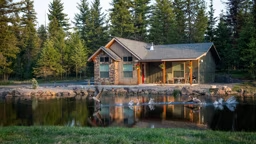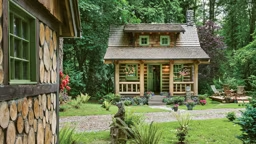Martha Nielsen has many fond childhood memories of spending long summer days at her Curtis grandparents’ old, rambling 11-bedroom farmhouse located on the coast of Maine.
She recalls the big Curtis family lobster picnics held out on the rocky point and how she and her curious cousins would free the crustaceans from their giant seaweed-filled baskets.
She also recalls grabbing the tin cups from the kitchen hall and racing out to the blueberry field to pick heaps of ripe, plump berries for her Grandma to transform into mouthwatering muffins, pies and pancakes.
Then, of course, there was the climbing of the linden tree – a rite of passage for all kids in the family when they reached a certain age. “I remember when I could finally get up to the bottom branches by myself,” says Martha. “And what a great time I had exploring the tree for years after that!”
But more recently Martha and her big family have been exploring ways to ensure that future generations can free the lobsters, eat berries and skin knees in their own little piece of vacation heaven
Saving Sea Winds
Back in the 1930s, Martha’s grandparents bought the property, which included 80 acres of woods and fields – and the farmhouse the Curtises named “Sea Winds” after a Longfellow poem. Through the years, Sea Winds has been a favorite gathering spot for the usual favorite cabin activities like swimming, sailing, cooking and kayaking. The farmhouse has also hosted six family weddings since the 1950s, starting with Martha’s parents. In 1993, Martha also had her own wedding reception at Sea Winds, complete with a buffet lunch in the barn, a champagne toast on the lawn – and a huge surprise in the woods.
“A group of our friends pooled their resources to get me and my husband a canoe,” recalls Martha. “During the reception, they hauled it out of the woods where they had hidden it.”
This was but one of many special memories that the family shares of the farmhouse.
Martha’s grandparents spent summers at Sea Winds until they passed away in the 1980s, leaving the farm to their three children (Martha’s mother and two uncles).
For years, the three siblings worked together to manage the property, but as they aged – and as the generations expanded into 34 direct descendants of Martha’s grandparents (with over 50 family members total), the task of property management became more burdensome and costly. Everyone wanted to keep the place in the family, but the question was, “What’s the best way to do that?”
Four years ago when the family began exploring their legal options, they found that asset protection was not as black-and-white as one might assume. If Martha’s mom and uncles did nothing and simply let their children some day inherit the property, then there would be a chunk of inheritance tax to pay.
That alone would mean that not every family member could afford to keep the place. Not to mention that sometimes inheritance can create friction and conflict within a family if siblings feel that there’s inequality in terms of who does or pays more to keep the place in good shape.
Another option was transferring ownership entirely. However, if Martha’s mom and uncles put the house in their children’s names, not only would they forfeit complete ownership themselves, but there was also another catch; Martha, her sister, and their cousins would have to shell out big bucks for capital gains tax. This would be a significant sum given the place is now worth 200 times the original purchase price (Martha’s grandparents were said to have paid $5,000 for the property during the Great Depression, and it is currently assessed at over $1 million). The Curtises then looked into a third option – a family trust – and thought, “Bingo!”
This Family’s Trust
A family trust, also called a living trust, is a discretionary trust set up to protect and pass family assets (in this case, the house and 80 acres of land) to future generations.
“If you’re looking into setting up a family trust, my advice is to not get yourself locked into someone else’s idea of what a trust should look like,” says Martha. “Make sure it’s right for your family and be sure that you have a mechanism to change it down the road. Ours – called a Revocable Real Estate Trust – can be amended or changed by consensus of the trustees.”
The trust is managed by six trustees who represent the three branches of the family. When the trust was initially set up, the family had to figure out how shares in the trust would be distributed. Ultimately, they decided that beneficiaries (direct descendants 18 years or older) would start out with an equal number of shares and then accrue additional shares upon paying what they termed an annual “maintenance fee,” which would go toward paying for repairs. To set the maintenance fee, the family averaged the amount spent on upkeep for the past 10 years.
“We’ve needed about $8,000 per year, so annually each beneficiary pays either $750, $350, or $200, depending on their age, starting at age 18,” says Martha, who notes that they cut the younger beneficiaries a break on the cost. They set up a three-tier fee schedule based on age and stage of life: 18- to 25-year-olds pay the least; 25- to 35-year-olds pay a greater portion; those over 35 pay the most. Parents of college students usually cover their son or daughter’s fees until they graduate and can start paying on their own.
The Curtises also decided that if a family member is unable to afford dues one year, they won’t slip backwards in shares; they simply won’t accrue an additional share that year.
Eight thousand dollars is usually sufficient for repairs, though there are years when big projects like replacing all the windows, re-roofing the house, and installing a septic system – all things Martha’s family has had to do – are necessary. As these projects cost more than $8,000, Martha’s mother or uncle has given the trust a short-term loan of a few thousand dollars to cover the cost of major repairs. Then the following year, in order to pay back the loan, the family scales back on maintenance expenditures by buying less expensive items like a new dishwasher or tackling DIY projects. Family members don’t get financial credit for doing small DIY projects. However, any family member who tackles a more time-consuming home maintenance project, like painting the house, gets paid like a local contractor (rather than having the money go toward his or her annual share).
Anybody (family member or visitor) who stays at the farmhouse pays an $8 per night “user fee.” This money goes toward paying taxes and utilities. Think of it as an overnight hotel charge, if you will – though the view from the Sea Winds sure beats the Super 8!
Talk It Out
From her experiences, Martha recommends that those involved in a family trust meet at least once a year to talk things out and make decisions. She admits that sometimes their meetings can get a little lively. “We’re a vocal family with differing opinions,” Martha says with a laugh. “But we always work things through.”
For the Curtises, it’s just not feasible to ask 50 family members to weigh in on all “house issues,” so designated trustees attend an annual family meeting. They identify and prioritize the most pressing maintenance issues, discuss the course of action for how named issues will be handled and set up sub-committees to handle the little things like repairing a door or cutting down a tree.
The process may sound complicated, but Martha insists that it’s actually pretty simple – provided that you talk to a lawyer who is familiar with the trust rules for the state the property is located in. Clearly, the effort put into the family retreat has innumerable rewards.
“Our family is spread all over the country – California, Georgia, Ohio, Minnesota, Massachusetts, Maine. We’d never see one another if it weren’t for having this common gathering place,” says Martha. “I treasure this house because it is the glue that holds our family together.”
And now thanks to the trust, this precious family heirloom will stay just that … in the family.
Freelancer Christy Heitger trusts that after reading this article her dad will set up a family trust for their northern Michigan cabin.










